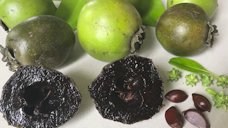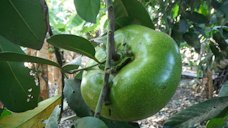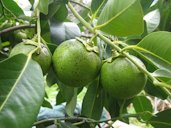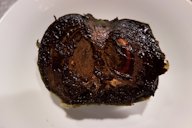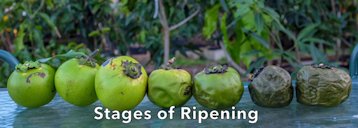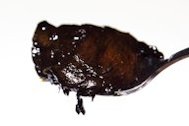| Black Sapote - Diospyros digyna | |||||||||||||||||||||||||||||
|---|---|---|---|---|---|---|---|---|---|---|---|---|---|---|---|---|---|---|---|---|---|---|---|---|---|---|---|---|---|
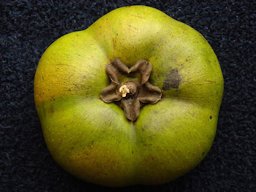 Fig. 1  A ripe, jumbo and seedless black sapote (Diospyros digyna, Ebenaceae) from a seedling tree in Palm Bay, Florida 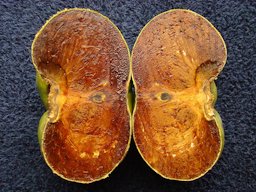 Fig. 2  The jumbo black sapote is shown here cut in half vertically, Palm Bay, Florida 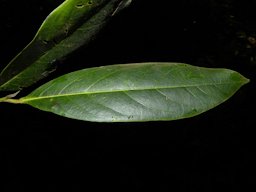 Fig. 4  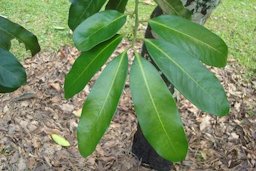 Fig. 5  Leaves  Fig. 6  Flowers forming 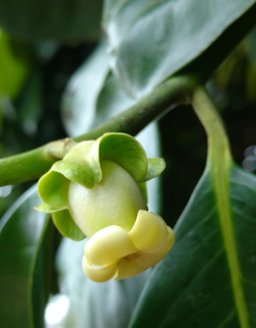 Fig. 7  Black sapote Tuxpan, Veracruz, México 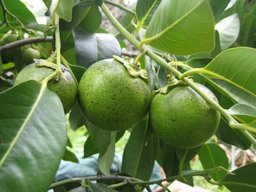 Fig. 9   Fig. 10  Black sapote D. nigra, Yucatan, Mexico 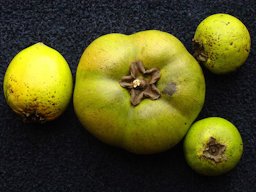 Fig. 11  Compared with three common black sapotes from three different trees, Palm Bay, Florida 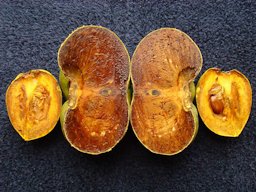 Fig. 12  The vertically cut halves of a ripe, jumbo and seedless black sapote from a seedling tree in Palm Bay, Florida, is compared with the same of a oval shaped common black sapote 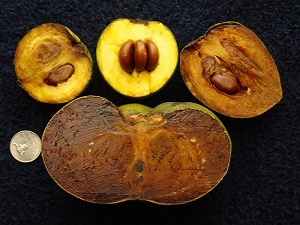 Fig. 13  The seedless black sapote, along with the three common black sapotes are compared with a 1in (2.5cm) diameter coin 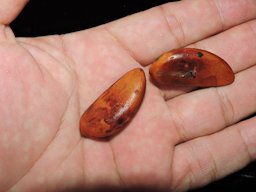 Fig. 18  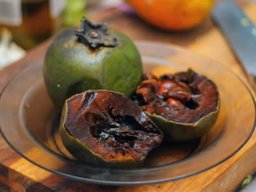 Fig. 19  Whole and opened ripe fruits 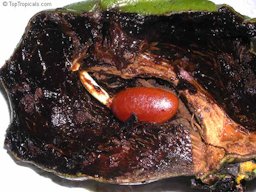 Fig. 24  Seed sprouting right inside the fruit 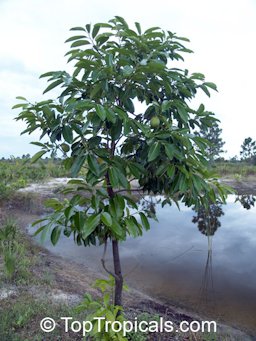 Fig. 25  Young tree 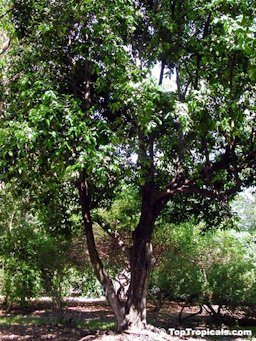 Fig. 26  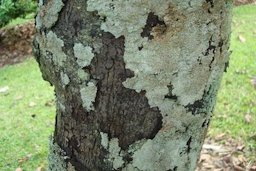 Fig. 27  Trunk 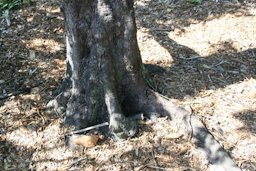 Fig. 28  |
Scientific
name Diospyros digyna Jacq. Common names English: black persimmon, black sapote, chocolate persimmon, chocolate pudding fruit, chocolate pudding tree, sapote negro, axle grease plant, black apple; Antilles: barbacoa, barbaquois, caca poule; Danish: sort ibenholt; French: barbaquois, ébénier des Antilles, kaki Noir, sapote noire, sapotier; Indonesia: sawo hitam; German: Ebenholzbaum, Schwarze Sapote; Japanese: diosupirosu nigura; Mexico: guayabota, zapote prieto, tliltzapotl (Aztec); Philippines: zapoté negro; Portuguese: ébano das Antilhas; Spanish: ebano, ébeno agrio, guayabota, matasano de mico, sapote, sapote negro, zapote, zapote ce mico, zapote negro, zapote prieto; Taiwan: Hei Shi 8 Synonyms D. edulis Lodd.; D. nigra Blanco; D. obtusifolia Willd.; D. obtusifolia Kunth; D. revoluta Poir.; D. sapotanigera DC.; D. tliltzapotl Sessé & Moç.; Sapota nigra J.F.Gmel. 4 Relatives Persimmon (D. kaki), American persimmon (D. virginiana), jackal berry (D. mespiliformis) an African species, date plum (D. lotus) from Asia, mabolo (D. blancoi) 1,2 Family Ebenaceae (ebony family) Origin Mexico and Central America USDA hardiness zones 10-12 11 Uses Fruit; shade tree; ornamental Height Medium 25-30 ft (7.6-9 m) to large trees 30-80 ft (9-24.5 m) 1 Crown Round and dense Canopy Thick, broad and irregular Growth rate The tree grows fairly slowly for the first 3–4 years, perhaps just 1 foot/year for the first couple of years; later however it grows much more rapidly 2,3 Pruning requirement Large tree that needs pruning for ease of harvest Leaves Evergreen; alternate; oblong; leathery; 4-12 in. (10-30 cm) long; glossy dark green 1 Flowers Arise in leaf axils and may be either hermaphroditic (possessing male and female plant parts) or male 1 Fruit Climacteric berry; oblate to globose; 2-6 in. (5-15 cm) in diameter; dark olive-green to bright green peel; persistent green calyx 1 Season Dec. through Feb. or June through Aug.; large trees may produce several hundred pounds a year 1 Light requirement Full sun Soil tolerances Grows well in most well drained soils, including sand and limestone-based, high-pH soils 1 pH preference 5.5-7.0 Drought tolerance Sensitive to drought but quite tolerant of flooding 3 Soil salt tolerance Low Cold tolerance Mature trees 28-30 °F (-2.2 to -1.1 °C); young trees will be killed at 23 °F (-5 °C) 6 Plant spacing Trees should be spaced 32-39 ft (10-12 m) apart 5 Invasive potential * None reported Pest resistance At present there are no major insect pests and diseases of black sapote in Florida 1 Reading Material Growing Black Sapote in the Florida Home Landscape, University of Florida pdf Cultural Calendar for the Black Sapote, University of Florida Black Sapote, Fruits of Warm Climates Chocolate Fruit for South Florida, Fairchild Tropical Botanic Garden Diospyros digyna, PROSEA Foundation Origin Probably a native to the forested lowlands of Mexico and Central America, it was taken by the Spanish to the Philippines and is now naturalized in the Moluccas and Sulawesi. The species has become indigenous to primary and secondary low- and medium-altitude forests in the Philippines. It is cultivated in Mexico and Guatemala and on a small scale in Hawaii, Florida and California but is a minor fruit elsewhere. Black sapote grows best in coastal areas from Jalisco to Chiapas, Veracruz and Yucatan. The tree has been cultivated in South Florida, in home gardens and small commercial orchards. 6 Description Ebenaceae family with about 500 species in the genus Diospyros. Related to persimmon and mabolo but not to white, green, yellow or mamey sapote. 9 For many years it has been widely misidentified as Diospyros ebenaster Retz., a name confusingly applied also to a strictly wild species of the West Indies now distinguished as D. revoluta Poir. 3 Black sapote trees are adapted to tropical and warm subtropical areas and may be planted from sea level to an altitude of about 6,000 ft. Trees appear to tolerate moderately windy areas, and if pruned regularly to limit tree size and open the canopy to wind movement can withstand hurricane- force winds without toppling. 1 The tree is usually andromonoecious or polygamous, some flowers have both male and female organs, others that are solely male have a gardenia-like scent. 6
Flowers Black sapote is usually dioecious, meaning that some trees produce only male flowers and no fruit and other trees produce female or bisexual flowers and fruit. Some trees may produce both male and female (or bisexual) flowers on the same tree. Male flowers are usually in clusters of 3 to 7, and female flowers are usually solitary. Flowers are white and tubular 0.4-0.6 in. (1-1.6 cm wide) with apersistent green calyx that resemble those of Diospyros kaki. and an 8- to 12-carpelled ovary. 1,6 Flowers are borne on the new shoots and hence the crop cycle is linked to flushing. In the subtropics certain trees seem to flower on the spring flush, others on the summer flush, corresponding to fruit maturing in late summer and in winter respectively. 10
Pollination Flowers are pollinated by insects. Some varieties may be self-incompatible and therefore require cross pollination with another variety or seedling that produces male or bisexual flowers in order to produce fruit. 1 Fruit Black sapote fruit are tomato-like and measure 2.0-3.9 in. (5-10 cm) in diameter, with an inedible skin and a pulp which is white and inedible when unripe but assumes a flavor, color and texture often likened to chocolate pudding when ripe. 5 The smooth, thin skin ripens to an olive to muddy green. The soft pulp is somewhat jelly-like, sweet and mild in flavour and brown to very dark brown. The fruit has one to ten flat, smooth, brown seeds 0.7-1 in. (2–2.5 cm long) or is seedless. 6
Varieties Selections have been made in the Philippines, Mexico, Australia and Florida. ‘Manilla’ and ‘Valesca’ are old, mainly seedless cultivars from the Philippines. Clonal selections in Australia have led to cultivars including ‘Bernecker’ seedless (also called 'Berniker') and ‘Maher’. In Florida, a selection made by the University of Florida named ‘Merida’ (also called 'Reineke') is propagated by grafting. 6 There are a number of other varieties that are not available locally yet. These include 'Mossman', 'Cocktail', 'Maher', 'Ricks Late', and 'Superb'. 1 'Merida' an Early Maturing Cultivar, State Horticultural Society pdf Harvesting Mature black sapote fruit change from a shiny green to dull green color and the lobes of the sepals (called the calyx) reflex upward (Fig. 14). Harvested fruit take 3 to 14 days to soften to eating quality. After fruit become ripe they may be stored in the refrigerator for several days for later use. 1 It is difficult to detect the slight color change of mature fruits amid the dense foliage of the black sapote tree. Many black sapotes ripen, fall and smash on the ground before one has the chance to pick them, and this is one reason why the tree is not favored for landscaping in urban areas. 3 Most black sapotes in Florida ripen in December, January or February. Certain trees, especially the large-fruited types, regularly come into season in June, others in July and August. 3
Propagation Seeds are usually used; these will germinate in about 30 days and if properly dried remain viable for several months. Seedlings grow slowly at first, they do not come true to type and may take 4-5 years to begin fruiting. Trees with only male flowers will not produce fruit; trees with female or male and female flowers will bear fruit. 8 Superior fruit varieties and selections are therefore propagated by budding and grafting. 1 Asexual propagation guarantees shorter trees and assures pistillate or female trees with good fruit quality will be obtained. The tree can be air layered and shield budded using mature but still green scions to get large 1.1-1.4 in. (3.0-3.5 cm) shields that can be budded. Cleft grafting and veneer grafting using scions 6 months of age are successful but the best grafting method is the lateral graft, leaving at least two leaves in the rootstock (Ledesma and Campbell, 2001). The scions should have two half leaves and the buds should be woody, but with no new growth. Grafted plants should be put under 70% shade and covered with a plastic bag for 3-4 weeks. The best time in Florida is September–October with 80% success. Seedling rootstocks are used for grafting and budding. Grafted or budded plants will flower in 3-4 years. 6 Tip Grafting, Archives of the Rare Fruit Council of Australia
Planting Proper planting is one of the most important steps in successfully establishing and growing a strong, productive tree. In general, black sapote trees should be planted in full sun for best growth and fruit production. 3 The tree is adapted to a wide range of soil types and can withstand salinity. It does best in a light, deep well-drained soil, rich in organic matter, but can grow in shallow soils as well. It is highly adaptive to calcareous soils and shows only minimal chlorosis from micronutrient deficiency. 6 Temperature The tree adapts itself to tropical and subtropical climates but prefers hot, low to middle elevation tropical areas without being truly tropical, since it can grow as far north as West Palm Beach in Florida, if protected from frost during the first years. Established trees can stand occasional short exposures to 28-30 °F (-2.2 to -1.1 °C) but 23 °F (-5 °C) will kill small or weak trees. 6 Pruning Formative pruning during the first 2 years may be desirable to encourage lateral branching and growth. Pruning should be done soon after after danger of frost has passed. Selectively removing a few upper limbs back to their origins (crotches) each year will help prevent the loss of the lower tree canopy due to shading by the upper canopy. 1 Irrigation Newly planted black sapote trees should be watered at planting and every other day for the first week or so and then 1 to 2 times a week for the first couple of months. Once black sapote trees are 4 or more years old watering will be beneficial to plant growth and crop yields only during very prolonged dry periods during the year. 1 Pests At present there are no major insect pests and diseases of black sapote in Florida. 1 Sri Lanka Weevils and Black Sapote, University of Florida, Lee County Extension pdf Food Uses Fruits are best eaten when fully ripe, the pulp becomes soft and pudding like at this stage. 8 The flavor is enhanced by the addition of honey, vanilla, cream or orange juice. The pulp can be used a a pie filling, in a mousse or can be baked into breads. It can also be used as a flavoring for ice cream. 2 Popular desserts include Black sapote mousse, cakes, cheese cakes, bavarois, custards, stuffing for pies and pastry, black sapote torte, black sapote topping (pulp, icing sugar, rum or brandy) or serving it as a sauce with papaya and ice cream. One popular dessert is “Black Sapote Fairy Queen Boat” which comprises black sapote topping, ice-cream, mixed fruit and with sherry or port. 8 In Mexico, the pulp may be mashed, beaten or passed through a colander and mixed with orange juice or brandy, and then served with or without whipped cream. Also, they sometimes mix the pulp with wine, cinnamon and sugar and serve as dessert called dulce de zapote (Fig. 18). Some Floridians use an eggbeater to blend the pulp with milk and ground nutmeg. A foamy, delicious beverage is made by mixing the pulp with canned pineapple juice in an electric blender. 3,7 The fruits are rich in minerals and vitamin C, containing about twice as much ascorbic acid as an orange. 7
Fig. 20. Zapote con naranja Fig. 22. Sweet Mexican vanilla black sapote bread Fig. 23. Dulce de zapote negro
Black Sapote Recipes, Fairchild Tropical Botanic Garden Virtual Herbarium Medicinal Properties ** The crushed bark and leaves are applied as a blistering poultice in the Philippines. In Yucatan, the leaf decoction is employed as an astringent and is taken internally as a febrifuge. Various preparations are used against leprosy, ringworm and itching skin conditions. 3,6 Other Uses Unripe fruits are inedible; they are hard, astringent because of the high tannin content, caustic and bitter, and have been used as fish poison in the Philippines and the West Indies. 10 The yellowish to deep yellow wood with black markings near the heart is suitable for cabinetwork and handcrafts. The tree is grown widely as an ornamental. 6 Other Edible Diospyros species: Common Persimmon, D. virginiana Japanese Persimmon, D. kaki Mabolo, D. blancoi Further Reading The Black Sapote, Manual Tropical Subtropical Fruits Black Sapote, Archives of the Rare Fruit Council of Australia Black Sapote Botanical Art List of Growers and Vendors |
||||||||||||||||||||||||||||
| Bibliography 1 Crane, Jonathan H., and Carlos Balerdi. "Black Sapote Growing in the Florida Home Garden." Horticultural Sciences Dept., UF/ IFAS Extension, HS1055, Original Pub. Nov. 2005, Revised Oct. 2006 and Nov. 2016, Reviewed Dec. 2019, AskIFAS, edis.ifas.ufl.edu/hs305. Accessed 16 Dec. 2014, 24 Jan. 2018, 19 June 2020. 2 Boning, Charles R. Florida's Best Fruiting Plants- Native and Exotic Trees, Shrubs, and Vines. Sarasota, Pineapple Press, 2006. 3 Fruits of Warm Climates. Julia F. Morton, Miami, 1987. 4 "Synonyms of Diospyros digyna Jacq." The Plant List (2013). Version 1.1. theplantlist.org. Accessed 22 May 2016. 5 "Diospyros digyna." Agroforestry, www.worldagroforestry.org. Accessed 24 May 2016. 6 Duarte, Odilo and Robert E. Paull. Exotic Fruits and Nuts of the New World. Cambridge, CABI, 2015. 7 Blancke, Rolf. Tropical Fruits and Other Edible Plants of the World: An Illustrated Guide. China, Comstock Publishing Associates, a division of Cornell University Press, 2016. 8 Lim T. K. "Edible Medicinal And Non-Medicinal Plants: Volume 2, Fruits." EPDF, 2012, epdf.pub/volume-2-fruits.html. Accessed 21 Nov. 2021. 9 "Black Sapote, Black Persimmon, Chocolate Pudding Fruit, Diospyros nigra (digyna)." The Rare Fruit Club WA, rarefruitclub.org.au/BlackSapote.htm. Accessed 21 Nov. 2021. 10 Ng, F. S. P. "Diospyros digyna Jacq." Edible fruits and nuts, Plant Resources of South-East Asia No 2, Edited by E. W. M. Verheij, and R. E. Coronel, PROSEA Foundation, Bogor, Indonesia, record 1500, 1991, PROSEA, (CC BY-NC-SA 3.0), www.prota4u.org/prosea/view.aspx?id=1500. Accessed 21 Nov. 2021. 11 "Diospyros digyna - Jacq." Plants For A Future, (CC BY-NC-SA 4.0), pfaf.org/user/Plant.aspx?LatinName=Diospyros+digyna. Accessed 21 Nov. 2021. Videos v1 "Chocolate Black Sapote - the chocolate pudding fruit." Daleys Fruit, Kath Kermode presenter, 25 Dec. 2019, (CC0), www.youtube.com/watch?v=rNHPoxRbflM. Accessed 19 Nov. 2021. v2 "Black Sapote - The chocolate pudding tropical fruit." Truly Tropical, 2 Mar. 2017, (CC0), www.youtube.com/watch?v=g93sWdOP9hs. Accessed 19 Nov. 2021. v3 "Field Trip Friday- Grafting Black Sapote with Julian Lara." Truly Tropical, 27 Dec. 2019, (CC0), www.youtube.com/watch?v=GfwGD87cjs8. Accessed 20 Nov. 2021. v4 Zoe. "Sugar Free Chocolate Pudding Fruit Mousse Recipe." Wildblend, 15 Dec. 2017, (CC0), www.youtube.com/watch?v=RswUgN2yst0. Accessed 20 Nov. 2021. Photographs Fig. 1,2,11,12,13 Ghosh, Asit K. "Black Sapote (Diospyros digyna/Ebenaceae)." Wikipedia, 2009, wikipedia.org. Accessed 16 Dec. 2014. Fig. 4,15 Galler, Yonathan. "Black Sapote Fruit, Israel." Wikipedia, 2007, wikipedia.org. Accessed 16 Dec. 2014. Fig. 5 Kwan. "Diospyros digyna." Plant Observatory, 2010, natureloveyou.sg. Accessed 16 Dec. 2014. Fig. 6 Gerus, Tatiana. "Flowers." Tropical Plants Database, (CC BY 2.0), tropical.theferns.info. Accessed 24 May 2016. Fig. 7 Sánchez, Mauricio Hernández. "Black Sapote Diospyros nigra, Tuxpan, Veracruz, México." iNaturalist Research Grade, 9 Aug. 3017, (CC BY-NC 4.0), Image cropped, www.inaturalist.org/observations/7426670. Accessed 22 Nov. 2021. Fig. 8 Tatters. "Flowering Sapote (Diospyros digyna)." Flickr, 2011, (CC BY-SA 2.0), flickr.com. Accessed 24 May 2016. Fig. 9 Yonygg. "Diospyros digyna." Tropical Plants Database, Public Domain, tropical.theferns.info/image.php?id=Diospyros+digyna. Accessed 21 Nov. 2021. Fig. 10 mdelapuent. "Black Sapote Diospyros nigra, Yucatan, Mexico." iNaturalist Research Grade, 13 Oct 2019, (CC BY-NC 4.0), www.inaturalist.org/observations/34331137. Accessed 22 Nov. 2021. Fig. 14 Fernández, C., and José Ramón. "Diospyros digyna (Zapote prieto, zapote negro)." Flickr, 2012, (CC BY-NC-SA 2.0), www.flickr.com. Accessed 24 May 2016. Fig. 16 Halans, Jean-Jacques. "Chocolate pudding fruit." Flickr, 2013, (CC BY-NC-SA 2.0), flickr.com. Accessed 24 May 2016. Fig. 17 "Black Sapote, Tips and Tricks for Picking, Ripening and Eating." Truly Tropical, 6 Dec. 2019, (CC0), www.youtube.com/watch?v=ZwoCKG3mT5w. Accessed 19 Nov. 2021. Fig. 18 Aguilar, Reinaldo. "Diospyros digyna Jacq." Vascular Plants of the Osa Peninsula, Costa Rica, 2014, Flickr, (CC BY-NC-SA 2.0), www.flickr.com. Accessed 23 May 2016. Fig. 19 Critical Miami. "Whole and opened ripe fruits." Wikipedia, 2008, wikipedia.org. Accessed 16 Dec. 2014. Fig. 20 Admiranda715. "Zapote con naranja, postre." Wikimedia Commons, 2012, (CC BY-SA 4.0), commons.wikimedia.org. Accessed 24 May 2016. Fig. 21 Cook, Dave. "Fruiteria Loma Bonita, zapote negro." Eating in Translation, 19 Mar. 2017, (CC BY-NC-ND 3.0 US), www.eatingintranslation.com/2017/03/fruteria-loma-bonita.html. Accessed 19 Nov. 2021. Fig. 22 Lucas, Rachelle. "Sweet Mexican Vanilla Black Sapote Bread." Flickr, 11 Mar. 2014, (CC BY-NC-ND 2.0), www.flickr.com/photos/thetravelbite/13103699694/in/photolist. Accessed 19 Nov. 2021. Fig. 23 "Dulce de zapote negro." El Bullir de Agus, (CC BY 4.0), elbullirdeagus.com/dulce-de-zapote-negro/. Accessed 19 Nov. 2021. Fig. 24,25 "Diospyros digyna, Diospyros obtusifolia." Top Tropicals, toptropicals.com. Accessed 16 Dec. 2014. Fig. 26 "Diospyros digyna, Diospyros obtusifolia, Black Sapote, Chocolate Pudding Fruit, Black/Chocolate Persimmon." Top Tropicals, toptropicals.com/cgi-bin/garden_catalog/cat.cgi?find=Ebenaceae&search_op=and&keyword_op=and&lang=e&number=5&imagesonly=1 no_change_lang =1&user=tt&first=5. Accessed 22 Nov. 2021. Fig. 27,28 Stang, David. "Base of trunk." Tropical Plants Database, (CC BY-NC-SA 3.0), tropical.theferns.info. Accessed 24 May 2016. * UF/IFAS Assessment of Non-native Plants in Florida's Natural Areas ** Information provided is not intended to be used as a guide for treatment of medical conditions. Published 16 Dec. 2014 LR. Last update 9 Jan. 2024 LR |
|||||||||||||||||||||||||||||
